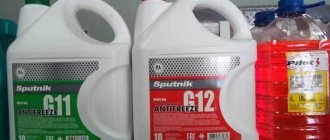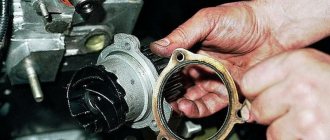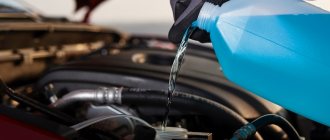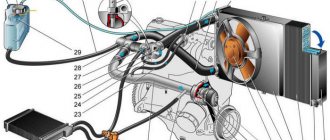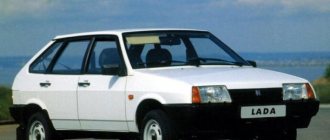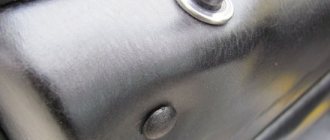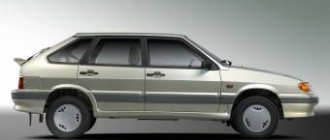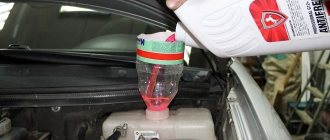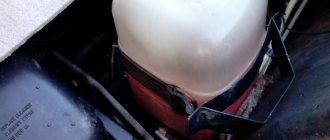How many liters are in the cooling system on a VAZ-2114: EXACT volume
Car : VAZ-2114. Asks : Sergey Smirnov. The essence of the question : How much coolant is there in the cooling system of the VAZ-2114, are you interested in the exact volume?
Good afternoon I have such a question! How much is needed for a complete replacement and how many liters of antifreeze are included in the entire VAZ-2114 engine cooling system? And in general, after what period of time does it need to be replaced?
Antifreeze or antifreeze from the factory?
The answer to this question is simple! AvtoVAZ does not maintain a uniform standard, and with equal probability, cars produced in the same year could contain both antifreeze and antifreeze. We have already written in more detail about the choice in the material: “what VAZ-2114 owners recommend: antifreeze or antifreeze.”
There is a lot of controversy about this, but opinions vary significantly, however, as the manufacturer states, it was TOSOL that was specially developed for cars of the VAZ family.
This fluid should be changed regularly and when these cases occur:
- After the last coolant change, the car has already traveled more than 65-70 thousand kilometers.
- Two years have passed since the last replacement, regardless of mileage.
- The liquid has a shade darker than its original color, or there are traces of rust.
This is the antifreeze that was drained at 40,000 km.
Source
What's in it?
So, you purchased a car and don’t know what exactly is in the cooling system. If there is water or already used coolant there, this does not bode well for your engine.
Therefore, first of all, check whether there is any coolant in the engine at all, and what exactly it is. At the same time, make sure there are no leaks from the pipes or radiator.
It is not difficult to independently determine the type of fluid used by the old owner.
- Antifreeze almost always has a blue or blue color.
- Antifreeze is mainly available in red or green. Moreover, there are a huge variety of shades of red.
- It is not difficult to distinguish water from blue or green liquid.
- If the color of the coolant has a characteristic shade of rust, then this indicates the need for urgent replacement.
Mixing different coolants. Yes or no?
In some cases, the quality of the fluid is good enough that it is not necessary to replace it. Only the quantity is somewhat below the required level.
Let's say you have antifreeze filled, but you only have antifreeze on hand. What to do in such a situation? Many VAZ 2114 owners are interested in whether it is possible to mix different compounds.
There is no consensus on this matter. Let us say for sure that a disaster will not occur from mixing, antifreeze and antifreeze will not react and will not explode the car. But we definitely cannot recommend combining two types of coolant in one tank. Follow the instructions in your car's manual, fill in what the factory recommends, and then you won't have any problems.
Antifreeze is simply a type of antifreeze developed in Soviet times for Zhiguli cars. This was done due to the low quality of the antifreeze offered at that time. Since then, antifreeze is the number one choice for VAZ.
How the cooling system works
To ensure timely cooling of the engine, an entire system consisting of several elements has been created. It includes:
- expansion tank, the main function of which is to store liquid in it;
- tank plug, necessary to normalize the pressure inside the system;
- radiator - the main cooling element that removes heat to the external environment;
- electric fan for cooling antifreeze;
- pipes through which coolant moves;
- thermostat - an element that controls the movement of antifreeze through the system;
- a pump that serves to pump coolant;
- the engine jacket through which antifreeze circulates.
The entire operation of the system depends on the serviceability of each element.
Antifreeze is intended for pouring specifically into VAZ cars
Coolant replacement timing
One of the questions that is important for car enthusiasts is how often to change the coolant. There are several factors on which this depends.
First of all, there are recommendations from manufacturers. They claim that replacement should be carried out no less often than the car has covered 60 thousand kilometers. If the car is used little, then replacement is needed every three years of operation. Otherwise, you should focus on the condition of the machine and pay attention to any problems that arise. The following signals indicate this:
- change in the original color of antifreeze;
- a leak occurs;
- overheating of the engine means that the antifreeze cannot cope with cooling and requires replacement.
If any of the problems occur, you should take the time to check the system. If defects in operation are detected, the coolant will need to be replaced.
What antifreeze to fill in VAZ 2114
For a high-quality result, you need to choose the right antifreeze. There is debate about what to pour into the VAZ 2114 system: the usual antifreeze or antifreeze. The manufacturer states that the antifreeze was developed specifically for this model. Therefore, it is better to purchase it as a replacement.
The concentrate should be diluted strictly according to the instructions. The ratio of antifreeze to water will determine at what temperature it will freeze. For VAZ 2114 it is best to use the A40 brand.
If you decide to pour antifreeze into a VAZ 2114, in order to avoid problems, it is better to use fluid from well-known brands with a good reputation: Lukoil Ultra and MOTUL Ultra.
Antifreeze should be selected strictly according to the car model
How much antifreeze is needed in a VAZ 2114
For the VAZ 2114 you can purchase two small canisters with a volume of 5 liters each. This will be enough to fill the system, provided that the concentrate is mixed with water according to the instructions.
How much antifreeze is in a VAZ 2114 8 valves
Many people are interested in how much antifreeze will fit into the tank of a VAZ 2114 with eight valves. This configuration is no different from others in terms of system volume. Therefore, for replacement you will need exactly the same amount as for other modifications of the VAZ 2114. According to the work algorithm, replacing the VAZ 2114 8 valve coolant will also not differ.
Specifications
Let's look at each element of this car separately and talk about its characteristics.
Body
The body of the 2114 is a hatchback and has remained virtually unchanged since 2003, only the equipment and various linings such as moldings and a spoiler have changed. In 2007, the body was restyled in which the car began to look prettier.
dimensions
Engine
The engine on the 2114 was installed in two capacities: 79 and 81 hp. there were also SuperAuto configurations with a 16-valve engine. The table below shows the technical characteristics of the engines installed on the 14th.
| Years of manufacture | 2003-2007 | 2007-2013 | |
| Engine | 2111 | 1183 | 21126 |
| Type | Petrol | Petrol | Petrol |
| Volume, l/cub. cm | 1,5/1498 | 1,6/1596 | 1,6/1596 |
| Power | 79 | 81 | 98 |
| Number of valves | 8 | 8 | 16 |
| Gas pedal drive | Cable | Cable, E-gas | E-gas |
| Fuel | AI - 92 | AI - 95 | AI - 95 |
| Number of cylinders | 4 | 4 | 4 |
| Number of valves per cylinder | 2 | 2 | 4 |
| Torque | 3800 | 3800 | 4200 |
| Supply system | Distributed injection | Distributed injection | Distributed injection |
| Fuel consumption, l. | 7,2 | 7,0 | 7,2 |
| Maximum speed, km/h | 160 | 170 | 183 |
| Engine location | Transversely, in front | Transversely, in front | Transversely, in front |
Gear box
The gearbox was inherited from the younger model and has five gear levels. A fairly reliable and unpretentious gearbox, the main “diseases” of which are the rapid failure of synchronizers and the crunch of second gear.
How to change antifreeze on a VAZ 2114
Replacing antifreeze in a VAZ 2114 consists of three main stages:
- draining old fluid;
- flushing the system;
- Filling a new portion of antifreeze.
To change antifreeze on a VAZ 2114, you need to prepare a certain set of tools and materials:
- personal protective equipment (gloves, goggles, overalls);
- several keys and screwdrivers;
- pliers;
- bulb for pumping out liquid;
- container for draining antifreeze;
- purified water;
- required volume of antifreeze VAZ 2114.
Work should begin by placing the car on a flat surface or by lifting it using specialized equipment.
How to drain antifreeze on a VAZ 2114
To drain the coolant completely, you need to do several manipulations:
- First, wait until the hot engine cools down.
- Then cover the generator to prevent antifreeze from getting on it.
- Remove the additional protection from the engine and the casing.
The expansion tank is made of plastic to make it easier to monitor the fluid level in it
You need to unscrew the plugs carefully so as not to cause liquid to splash.
If purging is difficult, you can flush the system. To do this, you will need purified water or special solutions purchased in stores.
The sequence of actions in this case is as follows:
- The bottom drain holes need to be screwed in.
- Water is poured into the hoses, and then the motor is turned on.
- Leave the car to cool the engine.
- Drain the flushing composition according to the same principle as the coolant.
If desired, the procedure can be repeated until clean water flows from the system.
You can simplify the procedure by using a hose with a constant supply of water.
Where to fill antifreeze in VAZ 2114
The process of filling the antifreeze system is no different from similar actions with other cars. The only caveat is that it is recommended to remove the fluid supply hose so as not to provoke the formation of air locks. When antifreeze comes out of the pipe when filling, it should be put back on.
Antifreeze should be poured into the VAZ 211Z and 2114 into the expansion tank. Its level must correspond to the upper limit mark. It is recommended to use a funnel to ensure a fine stream. In this case, you need to periodically squeeze the bleeding hoses to prevent bubbles from appearing.
After filling, you need to tighten the radiator and tank caps and warm up the engine. After the next cooling of the engine, you should check the fluid level in the expansion tank. If it is below normal, it is topped up to the maximum mark.
After the car has traveled 100-200 km, you need to check the fluid level and its quality. If the color changes, you will have to go through the whole procedure again, but with a different antifreeze.
The color of antifreeze does not depend on its class
How to choose the right composition?
In the instructions that come with the machine, the manufacturer advises using antifreeze type D as antifreeze, and Elf Glaceol RX Type D directly. This composition has a yellowish color. The product is supplied as a concentrate. While pouring this mixture, it must be diluted in distilled water. The ratio of concentrate and water should be 1 to 1. The price of this product is about 350 rubles. per liter This element is perfect for 1.4 and 1.6 liter engines. Buy unique concentrates recommended by the car manufacturer. Find these compounds available in stock at dealers. Such compositions also need to be diluted with distilled water. It is sold at the dealer or at car markets.
The Russian product, similar to the Elf brand, has also proven itself to be excellent. It's called Cool Stream 4030 Premium. Replacing antifreeze with Renault Logan involves completely replacing the old water with the newest one. For this purpose you need 2 or more 6 liters. consistency.
Experienced car enthusiasts also successfully use Elf Cool Auto Supra water. Antifreezes from . are also allowed for replacement. These waters do not harm plastic products and rubber parts. The Total composition does not have a destructive effect on paint and varnish coatings. Concentrates are very resistant to freezing. The liquid solidifies only at temperatures below .40 degrees. It makes no sense to combine antifreezes of different colors in the expansion tank for antifreeze. In the meantime, you need to carefully wash the entire system.
Tips for replacing coolant
When replacing antifreeze, you need to pay attention to some safety rules:
- All work can only be carried out on a cold engine.
- Do not allow antifreeze to come into contact with your skin. It is toxic and can cause burns.
- To drain the antifreeze, be sure to use containers so as not to pollute the soil.
- Do not mix liquids from different manufacturers.
- When pouring antifreeze, you need to monitor the volume of liquid poured so that it corresponds to the specified rating. If there is not enough of it, the engine will overheat.
Compliance with safety conditions will help avoid injuries and accidents.
Which specialist should I contact in case of poisoning?
Definitely see a toxicologist!
Poisoning is being treated in the toxicology department. First of all, it is aimed at removing poisons from the body; for this purpose, hemodialysis, hemosorption, forced diuresis, and partial blood replacement are performed.
Hemodialysis is most effective in the first 3-8 hours after the intake of poisons; it can be carried out in a medical institution that has an “artificial kidney” apparatus. If hemodialysis is not possible, blood replacement is performed.
To neutralize the breakdown products of ethylene glycol and create conditions for its excretion in the urine by drip and intravenous routes, a solution of magnesium sulfate is administered: 5 ml of magnesia solution (25%) per 100 ml of glucose solution (5%).
To combat acidosis, 1500-2000 ml of soda solution (3-5%) is injected into the intestines. The introduction of alkali is stopped when the urine becomes slightly alkaline.
To fully restore calcium in the blood, calcium chloride and/or calcium gluconate is injected intramuscularly with 10-20 ml of solution (10%).
To replenish vitamin reserves and restore damaged tissues, injections of vitamins C, B1, B12, and nicotinic acid are prescribed.
Perinephric blockade (injection of anesthetics into the perinephric space) eliminates pain and improves intestinal function.
If measures are taken in a timely manner, the prognosis is favorable; most of the functions of organs damaged by poisons will be restored.
How to check what kind of liquid is poured into the cooling radiator
Having bought a car secondhand, you just need to check the presence and level of coolant in the engine cooling system!
Its insufficient level can negatively affect the engine, not to mention the complete absence of fluid in the radiator. It is also worth checking if there are any leaks from the pipes, from the radiator, from the heater in the cabin.
If the old owner of the car forgot to say what liquid was poured into the radiator, you can try to determine its composition yourself. Antifreeze is almost always blue, antifreeze is usually green or red (red comes in different shades, even purple). If the color is unclear (rust color), then this composition must be changed. In general, after purchasing a used car, it is recommended to completely change the coolant.
Answers (2)
The total volume of coolant in the 2115 system is 7.8 liters. However, when replacing, it is often possible to fill less than 7 liters.
As for what to fill, it’s better, of course, to pour in antifreeze; gas stations and oil stores sell proven brands like Felix. Can be green or red. But if you have been filled with antifreeze, and you want to add antifreeze, then you need to drain the antifreeze. Washing is not necessary. If you just add, then pour only the one that was poured before.
For example, a friend’s “tag” was filled with antifreeze, then the liquid leaked out a little due to careless use - the tank lid was simply not closed. We added blue antifreeze, bought at the nearest gas station, to a level between the minimum and maximum.
Is it possible to mix different fluids in the cooling system?
Is it possible to mix antifreeze with antifreeze?
You should know that antifreeze is a type of antifreeze - it was specially developed for Zhiguli cars back in Soviet times. At that time, domestic antifreeze was not of good quality, and a better coolant composition for the new car model was simply necessary.
Car enthusiasts often ask whether it is possible to mix antifreeze with antifreeze. This issue is often discussed among car owners in real life, on various forums on the Internet. To be honest, they never came to a common opinion. One thing can only be said for sure - a catastrophe as such will not happen to the car. But still, it is not recommended to mix the compositions. It is better to adhere to the technical conditions and, for a certain car model, fill in the coolant that is recommended by the manufacturer for this brand of vehicle.
Coolant for VAZ 2114
What kind of coolant should I fill in the VAZ 2114? Maybe first you need to ask what kind of coolant is filled in at the factory? The Volzhsky Automobile Plant does not adhere to a single standard; in a VAZ 2114 car, with an equal degree of probability, there can be both antifreeze and antifreeze in the engine cooling system. But it is still recommended to fill in antifreeze, it is not for nothing that it was once specially designed for VAZ cars. The coolant must be changed periodically; this must be done in the following cases:
- 60 thousand kilometers after purchasing a new car;
- Every two years;
- If the coolant has a red tint or the liquid has become cloudy;
Rusty coolant
- If the coolant leaked and had to be diluted with water;
- When repairing, removing and installing an internal combustion engine (ICE).
In order to make a replacement, you need to know how much antifreeze there should be in the VAZ 2114 cooling system. According to the technical characteristics, 7.8 liters are poured into the VAZ 2114 internal combustion engine cooling system until it is fully charged.
The industry produces three types of ready-made antifreeze:
Antifreeze AK is a concentrate and cannot be used in its pure form. The concentrate is diluted one to one with water, then the freezing point of the coolant will be -30ºC. A65 freezes at -65ºC, the most popular brand is A40 (freezing point -40ºC). It is the A40 brand that is most often poured into the Zhiguli BA3 2114.
There is a question that arises before replacing the coolant - whether it is necessary to flush the cooling system when replacing antifreeze. The answer is this: if the old coolant is not cloudy and there are no sediments in the radiator in the form of insoluble flakes, it is not necessary to flush the system. But washing definitely won’t hurt, it won’t make it worse.
When to change?
We have already determined that, from the point of view of the needs of the VAZ 2114, antifreeze is best suited for this car. Although the plant itself has clear recommendations and standards in this regard. If you have a really high-quality antifreeze, which costs more than antifreeze, its performance efficiency will not be inferior to VAZ’s development, and in some places it may even be better.
But first, let’s determine exactly when the coolant needs to be replaced. It all depends on each specific situation, so there are several recommendations in this regard.
- When buying a new car, it should be replaced after every 60 thousand kilometers traveled.
- The standard service life of filled coolant is 2 years. Under normal operating conditions, it is sufficient to change it every two years.
- The coolant must be replaced immediately if its color has acquired a cloudy structure or a rusty tint.
- If the coolant leaked and water was used as a top-up, you need to eliminate the source of the leak and replace all the antifreeze.
- If the engine has been repaired or dismantled, the coolant must be replaced, regardless of its current condition.
What to fill?
A question that interests many is the volume of liquid that should be poured into the engine cooling system of the VAZ 2114. We answer. The volume of antifreeze or antifreeze is exactly 7.8 liters.
Since we agreed that antifreeze would be the best choice, let’s talk about its varieties and determine which one is best to use.
| Type of antifreeze | Peculiarities |
| AK | This antifreeze is a concentrate, so it cannot be poured in its pure form. Diluted with water in proportions of 1 to 1. The freezing point after dilution will be -30 degrees Celsius |
| A65 | Already diluted antifreeze that does not require adding water. The freezing point of the liquid is -65 degrees Celsius |
| A40 | The most common version of antifreeze for the VAZ 2114. Its freezing point is -40 degrees Celsius |
Decide for yourself which of this you will pour into the engine cooling system. Each of the three presented types of coolant has its own characteristics and works equally effectively for the benefit of your car.
Do not forget about the existence of high-quality antifreezes. They cost more, but last about 1-2 years longer.
How to flush the cooling system
Before replacing antifreeze on a VAZ 2114, in some cases you should first flush it. Flushing is necessary when scale forms in the cooling jacket of the internal combustion engine, or when engine oil gets into the radiator (oil gets in when the cylinder head gasket is faulty). Cleaning the system is very simple:
- The old coolant is drained (how to drain antifreeze from a VAZ 2114);
- Water is poured in (preferably boiled or distilled);
- The engine starts and idles for 20–30 minutes;
- The water is drained and the system is charged with new coolant.
Do-it-yourself replacement of VAZ 2114 coolant
Before replacing the coolant, the engine must first be cooled; work should be carried out on a cold engine. It goes without saying that the liquid should be purchased in advance. How many liters of antifreeze in a VAZ 2114 should be prepared for replacement? Although according to technical specifications the coolant should be about 8 liters, it is better to immediately purchase a 10-liter canister - in case it spills past the radiator.
On the VAZ 2114, replacing the coolant is easy. Let's consider an example of carrying out all operations on a car with an 8-valve engine.
Coolant replacement
We carry out the work in the following order:
- We unscrew the main engine protection. It is attached to the bottom of the engine compartment using four fasteners. Accordingly, if the protection is not worth it, then there is no need to turn it away.
- We remove the protective cover, which is located under the engine in the front part of the body.
- Remove the expansion tank plug.
- In the cabin, fully open the heater tap. This must be done so that when draining the coolant does not remain in the heating system.
- Prepare a container for draining the coolant. It is better to take a wide dish, for example, a basin. In this case, the coolant will not spill past.
- We find the drain plug on the radiator; it is located at the bottom near the generator. Before draining the radiator, you should somehow protect the generator from liquid getting on it.
- Drain the contents of the radiator.
- In order to get to the drain plug in the cylinder block, remove the ignition module. It is secured with three bolts.
- We remove the unscrewed module to the side; under it there is a drain plug. Unscrew it and drain the old coolant.
- We wait 10–15 minutes until everything merges.
- We tighten all the plugs.
How to add antifreeze to the cooling system? We place a funnel in the expansion tank and carefully pour the contents out of the canister, trying not to spill it past. After filling, we install all the removed parts in place. Then we start the engine and begin to warm up.
It should be noted that there is a high probability of an air lock forming in the cooling system, so it may not immediately enter the system. The volume of VAZ 2114 coolant is approximately 8 liters. Be guided by the amount of liquid remaining in the canister. If a blockage occurs, you should remove one of the hoses that go to heating the throttle valve and try to compress and release the upper radiator pipes. Antifreeze must pass into the system, making room for new fluid. There should be about two liters left in a ten-liter canister after all procedures.
Some tips
- Replacing antifreeze on a VAZ 2114 is carried out on a cold engine. It is not recommended to work on a hot internal combustion engine - there is a risk of burns.
- Before draining the coolant, protect the generator from moisture.
- When pouring antifreeze, you need to ensure that the entire required volume of liquid enters the cooling system. If it is less than required, the possibility of engine overheating cannot be ruled out.
- When mixing antifreeze and antifreeze, nothing particularly terrible will happen, but still, if possible, do not do this in order to avoid unexpected troubles.
In general, that’s all you need to know about how to replace the coolant on a VAZ 2114. The procedure is not complicated, you just need to do everything carefully and take your time.
Source
Preparation for replacement and necessary tools
You should start by preparing the car and workplace. The machine is placed on an overpass or above an inspection hole. It is recommended to leave it on the handbrake and at speed. And place “corners” under the wheels: stoppers to hold the car. After installation, it is worth checking the position of the machine. It should be level, or the front should be higher than the back. Other options are unacceptable.
The next stage of preparation for replacing the coolant in the VAZ 2107 is choosing tools . The list is short:
- A key for 13. It is recommended to additionally take a key for 8 and an adjustable key for 30. It is worth considering that used cars do not always use “original” spare parts. Therefore, the sizes of nuts and bolts may differ from the standard. Because of this, experienced drivers prefer to keep a set of keys of different sizes on hand.
- Screwdriver Set. It is worth having a flathead and Phillips screwdriver with you.
- Container for draining used antifreeze. Volume - 11-12 liters.
- Hose for the drain hole on the engine. Needed to remove antifreeze from the internal circuit of the system.
- Antifreeze to replace. Recommendations for selection and required volume are described above.
- Funnel for filling new coolant.
- WD-40 or equivalent. Used to remove dirt and rust from bolts and plugs.
Safety recommendations:
- You need to work on a cool engine. If the antifreeze is hot, allow it to cool. It must be remembered that the operating temperature of the coolant is 60-90 degrees. You cannot open the radiator and check the condition of the antifreeze. After all, the liquid, while hot, is under pressure in the system.
- The machine should be carefully secured in place. Any negligence in this matter can result in serious injury.
- Replacement is carried out in a well-ventilated area. It is worth remembering that antifreeze fumes are bad for your health.
- During operation, antifreeze must not enter the body. In particular, it should not come into contact with the eyes, mouth or respiratory tract.
Now you can proceed to the actual antifreeze replacement procedure. Conventionally, it is divided into three stages : draining the old coolant, flushing, and filling in new antifreeze. Each stage should be described separately.
Draining old fluid
First, you should remove the crankcase protection . And here it is worth remembering - on Zhiguli cars it is often in a deplorable state. The plate should be washed before removal. The bolts are treated with WD-40 to remove rust. If necessary, the entire part is cleaned of rust. The bolts are carefully unscrewed and the crankcase protection is removed. An important point: on old cars, the bolts rust and become brittle. If handled carelessly, they may break.
The heater lever opens in the cabin . It is transferred to the maximum position. There is no need to start the stove itself. Then the radiator filler neck and expansion tank are opened. This is done to speed up the draining. Then a container for used antifreeze is placed under the radiator drain hole. There are two options for draining the liquid.
They depend on the radiator model:
- Option with the “native” radiator of the VAZ 2107. The latest models of Zhiguli have a special tap for draining antifreeze. This faucet is treated with WD-40: it has a habit of turning sour. Then it opens and the liquid drains out.
- If a radiator from older models of the series is installed. There is no drain hole provided here. Therefore, the liquid is drained in one of two ways: The fan switch off sensor is unscrewed. It is located on the inside of the radiator, on the right (if you are facing the car). It will require a 30 key.
- Remove the hose from the lower radiator pipe.
After draining the coolant from the radiator, the internal circuit of the system should be emptied. You need to find the drain plug on the cylinder block. It looks like a 13mm wrench bolt. Use the appropriate wrench to unscrew the plug. The waste liquid is drained. To do this, you need to run the used coolant through a hose into a pre-prepared container.
The next step is draining the antifreeze from the expansion tank . You need to unfasten the container fastening belt. She herself is lifted 30-40 cm up. This will allow the remaining liquid to enter the radiator. From there it is drained using the method already described.
Flushing the cooling system
There are three ways to flush the cooling system: with water, household chemicals, and special compounds. And you should choose a method based on your preferences and the condition of the car. However, there is one important recommendation. Washing is not considered a mandatory procedure.
But there are a number of situations when it must be done:
- When switching to another coolant. The composition of different brands of antifreeze may differ. And mixing these liquids is not recommended. Even if both coolants are of high quality. This requires draining and complete flushing of the system.
- When traffic jams form in the system. Cleaning is a must here.
- When replacing the coolant in a recently purchased car. Owners of domestic cars often fill with low-quality antifreeze. And after it, a complete flushing of the system is always required.
You also need to flush the expansion tank . All hoses are disconnected from it and removed from the mounts. The container is thoroughly washed from the inside. Then the tank is put in place. It is worth checking the strength of the fastening belts. If necessary, they are replaced.
We recommend: Piston rings - what are they, why are they needed and how do they work?
Now it’s worth talking separately about each method of flushing the system.
Rinsing with distilled water
The simplest method. It is used only when the system is slightly contaminated.
The procedure looks like this:
- Distilled water is poured into the system through the expansion tank. Tap water is not recommended. Because of this, scale forms in the system. The volume of water for washing is 7-9 liters.
- The expansion tank plug is screwed in. The engine starts and warms up at idle speed to operating temperature. This is checked using the lower radiator pipe. The operating temperature is achieved when the upper and lower nozzles are heated equally. Then the motor warms up for 15-20 minutes.
- The engine stops and cools down. The temperature should drop to 25-30 degrees.
- Flushing water is drained from the system. The draining procedure is described above. It's worth checking the color of the water. Is it still transparent and free from dirt? No further cleaning is necessary. Is the water dirty and cloudy? The washing procedure is repeated.
It is not recommended to use water in older cars. It is better to clean the system with household chemicals or special compounds.
Washing with household chemicals
The most popular method among owners of domestic cars. For washing, use citric acid, vinegar, soda, etc. It is recommended to use citric acid . It is sold in powder form. The powder is diluted in water. The resulting solution is passed through the system for complete cleaning.
The washing procedure looks like this:
- For 6-7 liters of water, take 100-120 grams of powder. The components are mixed until the product is completely dissolved. It is recommended to use distilled water. In case of washing in “field conditions”, spring water is suitable.
- The product is poured into the radiator. The radiator cap is screwed on tightly.
- The engine warms up for 15-20 minutes. It is necessary to reach operating temperature. The heating process is the same as when using distillation.
- The motor is cooling down. The solution remains in the system for 2-3 hours.
- The mixture is drained. If necessary, the procedure is repeated.
There is one recommendation for repeated flushes . For mild contamination, it is worth reducing the concentration of citric acid by half. It is worth considering that when there is severe contamination, plugs form in the system. To eliminate them, the solution is driven through the circuit using a compressor.
Some drivers recommend using cola for washing . This drink quickly removes scale and dissolves antifreeze residues. But we must take into account: it contains sugar or its substitutes. And they remain on the walls of the pipes and radiator. And the coolant reacts with sugar. Because of this, it quickly deteriorates. And antifreeze has to be changed much earlier. Cola also corrodes rubber hoses. Because of this, they fail faster.
